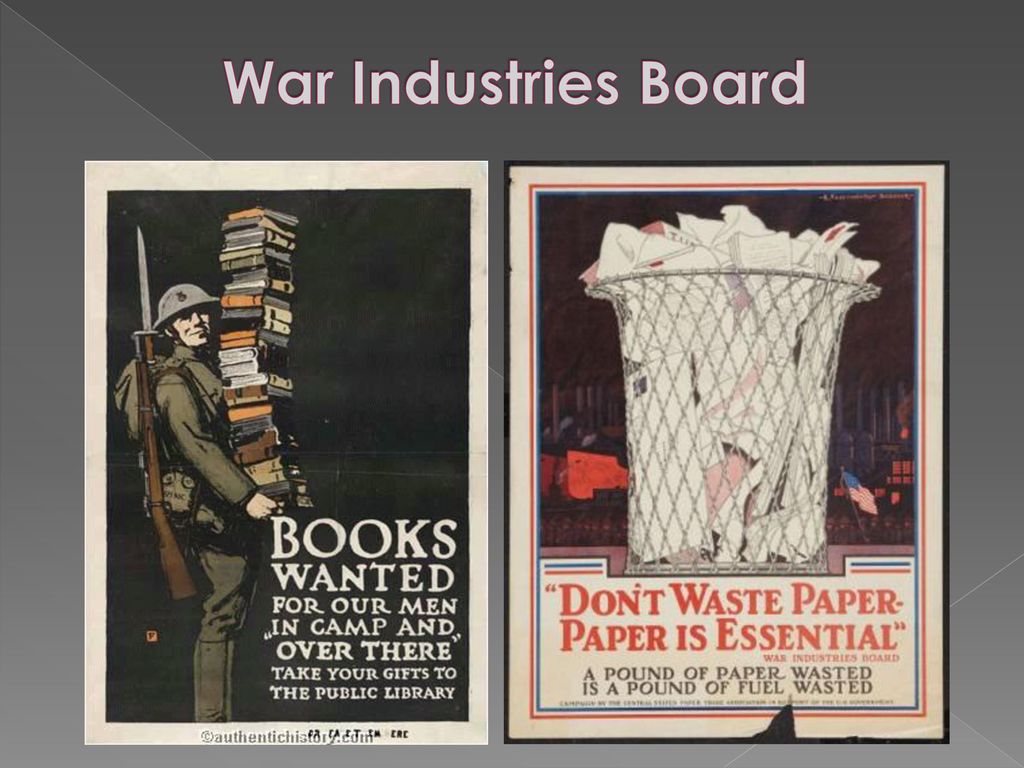War Industries Board And Food And Fuel Administration Definition
Food Will Win the War Eat local meatless Mondays go wheatless more fruits and vegetables less white sugar many of the things we hear a lot about today Americans did during the First World War. The purpose of the WIB was to coordinate the role of American industry during WW1 reorganizing and streamlining war-related industry through the management of resources production and distribution.
The War Industries Board WIB was created on July 28 1917 coordinating the production of war materials and the purchase of war supplies.

War industries board and food and fuel administration definition. This Board was a three-part body that dealt with specific industries labor-management disputes and wage control for industries essential to war efforts such as shipping railways automobile. Government also attempted to guide economic activity via centralized price and production controls administered by the War Industries Board the Food Administration and the Fuel Administration. Click here to get an answer to your question How were the war industries board the food administration and fuel administration similar.
Energy Information Administration International Energy Outlook 2016 113 Chapter 7 Industrial sector energy consumption Overview The industrial sector uses more delivered energy 294 than any other end-use sector consuming. The War Industries Board WIB was a United States government agency established on July 28 1917 during World War I to coordinate the purchase of war supplies between the War Department Department of the Army and the Navy Department. Learn vocabulary terms and more with flashcards games and other study tools.
The Food Administration agency headed by Herbert Hoover was created to conserve food by rationing and boost agricultural output in the US. The Fuel Administration run by Harry Garfield created the concept of fuel holidays encouraging civilian Americans to do their part for the war. FUEL ADMINISTRATIONFUEL ADMINISTRATION a World War I agency instituted 23 August 1917 under authority of the Lever Act.
By 1936 the War Industries Administration which was understood from the start to be the largest and most important wartime agency had been renamed the War Resources Administration. The board was established in 1917 but was later reorganized in 1918 under the leadership of Bernard M. WW1 Mobilization Fact 10.
Using this law Wilson created both a Fuel Administration and a Food Administration. This board urged companies to eliminate waste by standardizing products - such as only having 5 colors of type writer ribbons instead of 150. World War I Agencies.
Railroad Administration the Distribution Division controlled the distribution of coal and coke. The United States Fuel Administration was a World War I -era agency of the Federal government of the United States established by Executive Order 2690 of August 23 1917 pursuant to the Food and Fuel Control Act. The War Industries Board was established in July 1917 with the purpose of coordinating purchases by the United States government.
LEVER FOOD CONTROL ACT The Lever Food Control Act of 1917 authorized the president to regulate the price production transportation and allocation of feeds food fuel beverages and distilled spirits for the remainder of World War I 1914 19181918. Agriculture and food industriesfrom crop and animal production to food and beverage manufacturers foresters landscapers and horticulturalists--from throughout the Commonwealth came together to form an Agricultural Advisory Board. War Industries Board President Wilson appointed Bernard Baruch to head the board in March of 1918 during WWI--intended to restore economic order- to make sure we were producing enough at home and abroad--never had more than feeble formal powers--was disbanded a few days after the armistice.
WW1 Mobilization Fact 9. During a time of war however Holmes contended that Schencks actions represented a clear and present danger to the United States. Its responsibilities were to include.
Managed use of coal and oil. As part of the war effort the US. The agency exercised control over the production distribution and price of coal and oil.
War Industries Board WIB This board was the main regulatory body of the war. To conserve energy it introduced daylight saving time shortened. Only a few types of GMO crops are grown in the United States but some of these GMOs make up a large percentage of the crop grown eg soybeans corn sugar beets canola and.
Allocated coal and coke supplies to the army railroads and certain war. War Industries Board Fact 2. United States Fuel Administration.
DEMBELE DEMBELE 03182019 History Middle School answered How were the war 1. If words are used to create a clear and present danger to the nation Justice Holmes said the government has the right to suppress such behavior. The board was led at first by Frank Scott.
War Industries Board Agency overview Formed July 8 1917 Dissolved January 1 1919 Headquarters Washington DC. Start studying History 9 193-194. The war gave the government more power with the War Industries Board Food Administration Fuel Administration.
During World War I the economy was placed under an unprecedented degree of federal control to produce the materiel needed to win the war in Europe. In cooperation with the War Industries Board and the US. The War Industries Board WIB was a government agency that was created on July 28 1917 during World War 1War Industries Board Fact 3.
How Woodrow Wilson S Propaganda Machine Changed American Journalism

Us Energy System Solar Energy Facts Geothermal Energy Energy Industry

What Is Propaganda Propaganda Is A Specific Type Of Message Presentation Aimed At Serving An Agenda At Its Root The Denotation Of Propaganda Is To Ppt Download
War Industries Board Definition Significance Video Lesson Transcript Study Com



Komentar
Posting Komentar